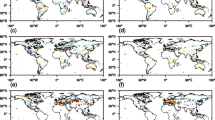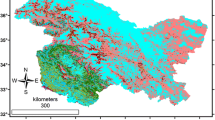Abstract
Change in potential natural vegetation (PNV) distribution associated with climate change due to the doubling atmospheric carbon dioxide (2×CO2) was estimated with a global natural vegetation mapping system based on the modified Kira scheme to the globe and the continents. With an input of widely-distributed global climate data, the system interpolates data onto a 1° latitude by 1° longitude grid over the globe, generates estimates of vegetation type, and produces a composite PNV map. The input climate data corresponding to the 1×CO2 and 2×CO2 consists of observations prior to AD 1958 at 2,001 weather stations worldwide and the 2×CO2 simulation output from the Japan Meteorological Research Institue's General Circulation Model, respectively. As a result of the simulated global warming, the vegetation zones expanded mostly from the tropics toward the poles. PNV area changed by 6.98 billion (G) ha of the total land area (15.04 Gha) and potential forest area corresponding to the closed forest and open forest (woodland) reached 9.74 Gha with the increase of 1.29 Gha. The potential forest area in Europe had obvious advantages to the climate change accompanied with the increase of actual forest area. Although the actual forest area has decreased in North America and Asia, the potential forest area in these continents also benefitted from the climate change. In the end, the remaining continents tended to bear the brunt of the climate change.
Similar content being viewed by others
Literature cited
Cha, G.S. (1995) Potential natural vegetation distribution based on the modified Kira's scheme. J. Jpn. For. Soc. 77:455–462.
Cha, G.S. and Sweda, T. (1993) Change in global vegetation caused by doubling atmospheric carbon dioxide. Advancement in forestry inventory and forest management sciences (Proc. IUFRO Seoul Conf. Sept. 20–25, 1993), 484–494.
Dale, V.H., Houghton, R.A., and Hall, C.A.S. (1991) Estimating the effects of land-use change on global atmospheric CO2 concentrations. Can. J. For. Res. 21:87–90.
Emanuel, W.R., Shugart, H.H., and Stevenson, M.P. (1985a) Climate change and the broad-scale distribution of terrestrial ecosystem complexes. Clim. Change 7:29–43.
Emanuel, W.R., Shugart, H.H., and Stevenson, M.P. (1985b) Response to comment: Climate change and the broad-scale distribution of terrestrial ecosystem complexes. Clim. Change 7:457–460.
Food and Agriculture Organization of the United Nations (1994) Agrostat PC, on diskette. FAO, Rome.
Gütter, P.J. and Kutzbach, J.E. (1990) A modified Köppen classification applied to model simulations of glacial and interglacial climates. Clim. Change 16:193–215.
Holdridge, L.R. (1947) Determination of world plant formations from simple climatic data. Science 105: 367–368.
Kira, T. (1976) Rikujou Seitaikei Gairon. 166pp, Kyouritsu, Tokyo. (in Japanese)
Kitoh, A. (1991a) International variation in an atmospheric GCM forced by the 1970–1989 SST Part I: Response of the tropical atmosphere. J. Meteor. Soc. Jpn. 69:252–269.
Kitoh, A. (1991b) International variation in an atmospheric GCM forced by the 1970–1989 SST Part II: Low-frequency variability of the wintertime northern hemisphere extratropics. J. Meteor. Soc. Jpn. 69:271–291.
Mather, A.S. (1990) Global forest resources. 324pp, Belhaven Press, London.
Monserud, R.A. and Leemans, R. (1992) Comparing global vegetation maps with the Kappa statistics. Ecol. Modeling 62:275–293.
Prentice, K.C. and Fung, I.Y. (1990) The sensitivity of terrestrial carbon storage to climate change. Nature 346:48–51.
Robinson, J., Brush, S., Douglas, I., Graedel, T.E., Graetz, D., Hodge, W., Liverman, D., Melillo, J., Moss, R., Naumov, A., Nijru, G., Penner, J., Rogers, P., Ruttan, V., and Sturdevant, J. (1994) Land-use and land-cover projections: Report of working group C. Change in land use and land cover: A global perspective. Meyer, W. B. and Turner II, B. L. (eds.), xi+537pp, Cambridge University Press, UK.
Walter, H. (1984) Vegetation of the earth and ecological systems of the geobiosphere, Third ed. xvi+318pp, Springer-Verlag, Berlin.
WeatherDisc Associates, Inc. (1990) World WeatherDisc.
Author information
Authors and Affiliations
About this article
Cite this article
Cha, G. The impacts of climate change on potential natural vegetation distribution. J. For. Res. 2, 147–152 (1997). https://doi.org/10.1007/BF02348212
Accepted:
Issue Date:
DOI: https://doi.org/10.1007/BF02348212




